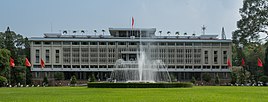Huha
Huha
Kapeçarioka, Riverhead | |
|---|---|
From top, left to right: Skyline of Huha's centre district; Cathedral Basilica of Huha; Huha Opera House; President's Palace; Huha Centre Station; and Federal Assembly of Phou | |
| Country | Phou |
| Area | |
| • City | 2,061.2 km2 (795.83 sq mi) |
| • Metro | 30,595 km2 (11,813 sq mi) |
| Elevation | 19 m (63 ft) |
| Population | |
| • City | 8,993,082 (1st) |
| • Density | 4,292/km2 (11,120/sq mi) |
| • Metro | 21,281,639 |
| • Metro density | 697.2/km2 (1,806/sq mi) |
| Demonym | Huhani |
Huha is the capital and largest city of Phou. With nearly 9 million inhabitants within its city limits and more than 21 million in its surrounding metropolitan area, Huha is one of the largest cities in Ausiana and in the world, contributing more than half of Phou's total population. Huha was the administrative centre of many kingdoms throughout history, namely the Thamphu dynasty. When Phou became a colony of Zoygaria alongside Muonang and Cong Quoc, Huha was renamed Kapeçarioka, otherwise known as Riverhead, and was the colony's capital. Upon independence in 1956, Huha once again became the capital of a united Phou, though the city sustained major damage during the 1957-78 civil war. Beginning in the 1990s, the city underwent rapid modernisation and expansion, contributing to Huha's post-war economic recovery.
Its varied cultural institutions, which include historic landmarks, walking streets, museums and galleries, attracts over 10 million international visitors each year. Huha is a major centre for finance, media, technology, education, and transportation. The city generates nearly a quarter of the country's total GDP, and is home to many multinational companies. Tan Nat International Airport, the main airport serving the city, is the busiest airport in the country by passenger traffic, accounting for nearly half of all international arrivals to Phou.





